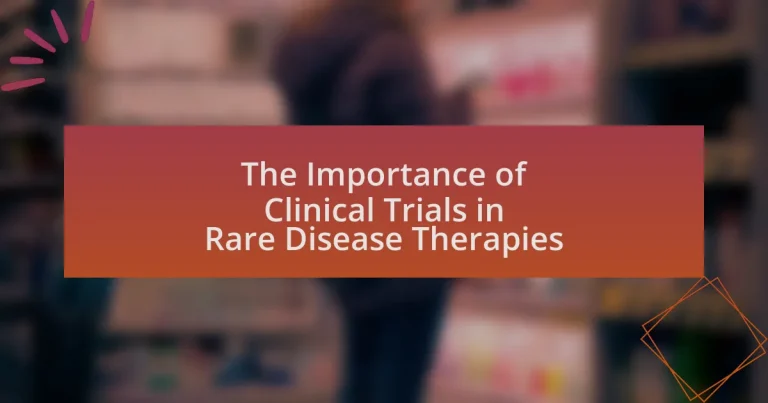Clinical trials are systematic studies essential for evaluating the safety and efficacy of new therapies, particularly for rare diseases that affect approximately 30 million Americans. This article explores the significance of clinical trials in developing treatments for rare diseases, detailing the phases involved, the challenges faced in patient recruitment, and the regulatory hurdles that can impede progress. It also highlights the roles of stakeholders, including pharmaceutical companies and patient advocacy groups, in shaping trial outcomes and ensuring ethical considerations are met. Furthermore, the article discusses best practices for conducting trials and the impact of successful trials on treatment options and understanding of rare diseases.
What are Clinical Trials and Why are They Important for Rare Disease Therapies?
Clinical trials are systematic studies conducted to evaluate the safety and efficacy of new treatments, including therapies for rare diseases. They are crucial for rare disease therapies because they provide the necessary evidence to support regulatory approval and ensure that treatments are both safe and effective for patients with conditions that often lack existing treatment options. According to the National Institutes of Health, approximately 7,000 rare diseases affect an estimated 30 million Americans, highlighting the need for targeted research through clinical trials to develop effective therapies for these conditions.
How do Clinical Trials contribute to the development of therapies for rare diseases?
Clinical trials are essential for the development of therapies for rare diseases by providing a structured method to evaluate the safety and efficacy of new treatments. These trials enable researchers to gather critical data on how a therapy interacts with a specific rare disease, often involving small patient populations due to the limited number of individuals affected by such conditions. For instance, the Orphan Drug Act in the United States incentivizes the development of treatments for rare diseases by offering benefits like tax credits and market exclusivity, which encourages pharmaceutical companies to invest in clinical trials. Furthermore, clinical trials often utilize innovative designs, such as adaptive trials, which allow for modifications based on interim results, thus optimizing the development process for rare disease therapies.
What phases do Clinical Trials typically involve?
Clinical trials typically involve four main phases: Phase I, Phase II, Phase III, and Phase IV. Phase I focuses on assessing the safety and dosage of a new treatment in a small group of healthy volunteers. Phase II evaluates the treatment’s efficacy and side effects in a larger group of participants who have the condition. Phase III involves a larger population to confirm effectiveness, monitor side effects, and compare it to standard treatments. Finally, Phase IV occurs after the treatment is approved, monitoring long-term effects and further evaluating its effectiveness in the general population. Each phase is crucial for ensuring the safety and efficacy of new therapies, particularly in the context of rare diseases where clinical evidence is essential for treatment validation.
How do Clinical Trials ensure patient safety and efficacy of treatments?
Clinical trials ensure patient safety and efficacy of treatments through rigorous protocols that include preclinical testing, phased trial designs, and continuous monitoring. These trials begin with preclinical studies to assess potential risks and benefits before human testing. In Phase I trials, a small group of healthy volunteers is exposed to the treatment to evaluate safety and dosage. Phase II trials involve a larger group of patients to assess efficacy and side effects, while Phase III trials compare the new treatment against standard therapies in diverse populations to confirm effectiveness and monitor adverse reactions. Regulatory bodies, such as the FDA, require comprehensive data from these trials to ensure that treatments are both safe and effective before approval. This structured approach, supported by statistical analysis and peer-reviewed research, underpins the integrity of clinical trials in safeguarding patient health while advancing medical knowledge.
What challenges do Clinical Trials face in the context of rare diseases?
Clinical trials for rare diseases face significant challenges, primarily due to the limited patient population available for study. This scarcity makes it difficult to recruit enough participants, which can lead to prolonged trial timelines and increased costs. Additionally, the heterogeneity of rare diseases complicates the design of trials, as variations in disease presentation can affect treatment responses and outcomes. Regulatory hurdles also pose challenges, as obtaining approval for trials in rare diseases often requires extensive data that may not be readily available. Furthermore, the lack of established endpoints and biomarkers for many rare diseases can hinder the assessment of treatment efficacy. These factors collectively contribute to the complexity and difficulty of conducting clinical trials in the context of rare diseases.
Why is patient recruitment particularly difficult for rare disease Clinical Trials?
Patient recruitment is particularly difficult for rare disease clinical trials due to the limited number of eligible patients. Rare diseases, defined as conditions affecting fewer than 200,000 individuals in the United States, often result in small patient populations, making it challenging to find enough participants for studies. According to the National Institutes of Health, there are over 7,000 rare diseases, which collectively affect approximately 30 million Americans, but the rarity of each condition means that many patients may not be aware of ongoing trials or may not meet specific eligibility criteria. This scarcity of potential participants, combined with geographical dispersion and the complexity of the diseases, significantly hampers recruitment efforts.
How do regulatory hurdles impact the progress of Clinical Trials for rare diseases?
Regulatory hurdles significantly delay the progress of clinical trials for rare diseases by imposing stringent requirements that can slow down the approval process. These hurdles often include extensive documentation, lengthy review periods, and the need for additional safety and efficacy data, which can be particularly challenging for rare diseases that may have limited patient populations. For instance, the FDA’s Orphan Drug Act provides incentives for developing treatments for rare diseases, yet the initial regulatory requirements can still create barriers that prolong trial timelines. Consequently, these delays can hinder timely access to potentially life-saving therapies for patients suffering from rare conditions.
What is the Role of Stakeholders in Clinical Trials for Rare Diseases?
Stakeholders play a crucial role in clinical trials for rare diseases by influencing trial design, recruitment, and regulatory processes. Their involvement ensures that the perspectives of patients, caregivers, healthcare providers, and industry representatives are integrated, which enhances the relevance and quality of the research. For instance, patient advocacy groups often provide insights into the specific needs and challenges faced by individuals with rare diseases, which can shape the endpoints and outcomes measured in trials. Additionally, stakeholders can facilitate patient recruitment by leveraging their networks and raising awareness about the trials, addressing the common challenge of limited participant availability in rare disease studies. Their engagement also aids in navigating regulatory pathways, as stakeholders can provide feedback to regulatory agencies, ensuring that the trials meet both scientific and ethical standards.
How do pharmaceutical companies influence Clinical Trials for rare diseases?
Pharmaceutical companies influence clinical trials for rare diseases primarily through funding, design control, and regulatory interactions. By providing financial resources, these companies can dictate the scope and methodology of trials, often prioritizing their own drug candidates. For instance, a study published in the Journal of Rare Diseases highlighted that over 70% of rare disease trials are sponsored by pharmaceutical companies, which allows them to shape trial parameters to favor their products. Additionally, companies often engage in strategic partnerships with academic institutions to leverage expertise while maintaining control over data and outcomes. This influence can lead to biases in trial results, as companies may focus on endpoints that showcase their drug’s efficacy while downplaying adverse effects.
What are the responsibilities of researchers in conducting Clinical Trials?
Researchers in conducting clinical trials are responsible for ensuring the safety and well-being of participants, adhering to ethical standards, and maintaining scientific integrity. They must obtain informed consent from participants, which involves clearly communicating the trial’s purpose, procedures, risks, and benefits. Additionally, researchers are tasked with designing the study protocol, recruiting participants, and monitoring their health throughout the trial to identify any adverse effects. They must also ensure compliance with regulatory requirements and report findings accurately, contributing to the body of knowledge in rare disease therapies. These responsibilities are critical for the credibility of the research and the advancement of medical science.
How do patient advocacy groups contribute to the success of Clinical Trials?
Patient advocacy groups significantly enhance the success of clinical trials by facilitating patient recruitment and engagement. These organizations often have established networks and trust within patient communities, which can lead to increased participation in trials. For instance, a study published in the Journal of Clinical Oncology found that trials supported by advocacy groups had higher enrollment rates, with some reporting up to 50% more participants compared to those without such support. Additionally, patient advocacy groups provide valuable insights into patient needs and preferences, helping to shape trial design and improve retention rates. Their involvement can also lead to increased awareness and education about clinical trials, further driving participation and ultimately contributing to the overall success of the research.
What ethical considerations arise in Clinical Trials for rare diseases?
Ethical considerations in clinical trials for rare diseases include informed consent, risk-benefit analysis, and equitable access to treatment. Informed consent is crucial as participants often have limited information about the disease and potential treatments, necessitating clear communication about risks and benefits. Risk-benefit analysis is particularly challenging due to the small patient population, where the potential for significant benefits must be weighed against the risks of participation. Additionally, equitable access to experimental therapies raises concerns about fairness, as patients with rare diseases may face barriers in accessing trials, leading to disparities in treatment opportunities. These considerations are essential to ensure ethical integrity in the development of therapies for rare diseases.
How is informed consent obtained from participants in Clinical Trials?
Informed consent is obtained from participants in clinical trials through a structured process that ensures participants understand the study’s purpose, procedures, risks, and benefits. This process typically involves providing potential participants with a detailed informed consent document that outlines all relevant information in clear language. Participants are encouraged to ask questions and must voluntarily agree to participate without any coercion.
The ethical guidelines established by organizations such as the Declaration of Helsinki and the Belmont Report emphasize the necessity of informed consent in protecting participants’ autonomy and rights. Additionally, regulatory bodies like the FDA and EMA require that informed consent be documented and that participants are given adequate time to consider their decision before enrolling in a trial.
What measures are taken to protect vulnerable populations in Clinical Trials?
Measures taken to protect vulnerable populations in clinical trials include obtaining informed consent, implementing additional ethical oversight, and ensuring equitable access to trial participation. Informed consent processes are designed to ensure that participants fully understand the risks and benefits of the trial, particularly for those who may have cognitive impairments or limited health literacy. Ethical oversight is often enhanced through the involvement of Institutional Review Boards (IRBs) that specifically evaluate the risks to vulnerable groups, such as children, the elderly, or individuals with disabilities. Additionally, researchers may provide support services, such as counseling and transportation, to facilitate participation and ensure that vulnerable populations are not unduly burdened by the trial process. These measures are supported by regulatory frameworks, such as the U.S. Department of Health and Human Services regulations, which mandate protections for vulnerable populations in research settings.
What are the Outcomes and Impacts of Clinical Trials on Rare Disease Therapies?
Clinical trials on rare disease therapies lead to significant outcomes, including the development of effective treatments, improved patient quality of life, and enhanced understanding of disease mechanisms. These trials often result in the approval of new therapies, as evidenced by the FDA’s Orphan Drug Act, which incentivizes the development of treatments for rare diseases affecting fewer than 200,000 individuals in the U.S. For instance, between 1983 and 2020, over 700 orphan drugs were approved, demonstrating the direct impact of clinical trials on therapeutic advancements. Additionally, successful trials contribute to the body of scientific knowledge, facilitating further research and innovation in rare disease management.
How do successful Clinical Trials affect treatment options for patients?
Successful clinical trials expand treatment options for patients by providing evidence-based data that supports the efficacy and safety of new therapies. When a clinical trial demonstrates positive outcomes, regulatory agencies like the FDA may approve the treatment for public use, thereby making it accessible to patients who previously had limited options. For instance, the approval of the drug Spinraza for spinal muscular atrophy followed successful clinical trials, significantly improving patient outcomes and quality of life. This process not only introduces innovative therapies but also encourages further research and development in rare diseases, ultimately enhancing the overall landscape of treatment options available to patients.
What role do Clinical Trials play in gaining regulatory approval for new therapies?
Clinical trials are essential for gaining regulatory approval for new therapies as they provide systematic evidence of a treatment’s safety and efficacy. Regulatory agencies, such as the FDA and EMA, require data from clinical trials to assess whether a new therapy meets the necessary standards for approval. These trials are conducted in phases, starting with small groups to evaluate safety and progressing to larger populations to confirm effectiveness and monitor side effects. For instance, the FDA’s approval of the gene therapy Zolgensma for spinal muscular atrophy was based on robust clinical trial data demonstrating significant improvements in motor function. Thus, clinical trials serve as the foundational process through which new therapies are validated and authorized for public use.
How do Clinical Trials contribute to the understanding of rare diseases?
Clinical trials contribute to the understanding of rare diseases by providing systematic data on disease mechanisms, treatment efficacy, and patient responses. These trials often involve a small number of participants due to the rarity of the conditions, allowing researchers to gather detailed insights into the biological and clinical aspects of the diseases. For instance, the National Institutes of Health (NIH) emphasizes that clinical trials are essential for developing new therapies and improving diagnostic methods for rare diseases, as they facilitate the collection of critical information that can lead to better understanding and management of these conditions.
What are the best practices for conducting Clinical Trials in rare diseases?
The best practices for conducting clinical trials in rare diseases include early and continuous engagement with patient advocacy groups, utilizing adaptive trial designs, and ensuring robust data collection methods. Engaging with patient advocacy groups helps to identify patient needs and improve recruitment strategies, as these organizations often have established networks within the patient community. Adaptive trial designs allow for modifications based on interim results, which is crucial in rare diseases where patient populations are small and data may be limited. Additionally, employing robust data collection methods ensures the integrity and reliability of the trial results, which is essential for regulatory approval and subsequent treatment development. These practices are supported by the FDA’s guidance on rare diseases, which emphasizes the importance of patient input and innovative trial designs to facilitate drug development in these challenging areas.
How can researchers improve patient recruitment and retention in Clinical Trials?
Researchers can improve patient recruitment and retention in clinical trials by implementing targeted outreach strategies and enhancing patient engagement. Targeted outreach involves identifying and connecting with specific patient populations through collaborations with patient advocacy groups and utilizing social media platforms to disseminate information about the trials. Enhanced patient engagement can be achieved by providing clear, accessible information about the trial’s purpose, procedures, and potential benefits, as well as offering support services such as transportation and financial assistance. Studies have shown that trials with strong patient engagement strategies see higher retention rates; for example, a systematic review published in the Journal of Clinical Epidemiology found that effective communication and support significantly improved participant retention in clinical studies.
What strategies can be employed to navigate regulatory challenges effectively?
To navigate regulatory challenges effectively, organizations should implement proactive engagement with regulatory bodies, thorough understanding of regulatory requirements, and robust compliance frameworks. Proactive engagement involves establishing open lines of communication with regulators to clarify expectations and address concerns early in the process. A thorough understanding of regulatory requirements ensures that all aspects of clinical trials, particularly in rare disease therapies, align with guidelines set by authorities such as the FDA or EMA. Additionally, robust compliance frameworks, including regular audits and training for staff, help maintain adherence to regulations and mitigate risks of non-compliance. These strategies are supported by the fact that organizations that engage early with regulators often experience smoother approval processes, as evidenced by studies showing reduced time to market for therapies that incorporate regulatory feedback during development.





